A billion birds?
The image is hard to process.
Even more so a billion dead birds.
But that’s what’s been counted on an annual basis in North America. Crashes into windows kill 16 to 42 million birds a year in Canada. In the United States, collisions kill 365 to 988 million birds per year.
Collisions are one of the top sources of human-caused bird mortality, despite being easily preventable.
Toronto was the first city in North America to officially adopt migratory bird protection and crash prevention policies, like those requiring new developments to have bird-friendly building and protective glass features. As part of the city’s continuing efforts, the annual “Lights Out Toronto” campaign to address collision incidents with building windows is on now (the spring campaign runs until May 31).
It was back in 2016 when the city released its guide to Best Practices for Bird Friendly Glass, with several recommendations for treating windows (and adjusting lighting) to protect birds in flight.
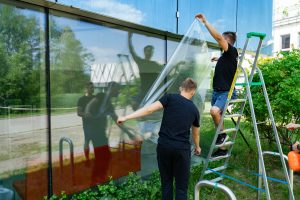
An advanced UV-active adhesive film product from Europe, BirdShades, is now being distributed by an Ontario company. The UV treatment is said to reduce bird collisions by tens of millions. BirdShades image.
And while some collision solutions are decidedly home-grown, low-tech, and do-it-yourself, new high-tech products continue to be developed and to come to market.
For example, a Guelph, Ontario-based firm says it’s addressing the issue by distributing an advanced UV-active adhesive film product that is invisible to humans, but highly visible to birds. Comprehensive use and installation is said to be able to reduce bird collisions by tens of millions.
Headquartered in Guelph, Tekton Performance Films specializes in providing a range of high-performance window films as automotive, architectural, and structural security solutions.
In a new distribution agreement with a European company called BirdShades, Tekton will
oversee product certification, sales, and distribution of bird-protective products throughout North America.
The new partners want to make sure that architects, developers, institutional building managers, and window installers have knowledge and access to new state-of-the-art materials with modern design and sustainability standards.
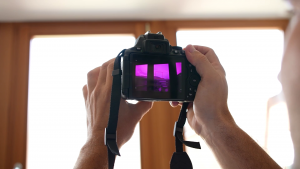
BirdShades’ fully transparent (to us) window covering reflects light in specific UV frequencies that most birds can see (and that a UV sensitive camera can reveal). BirdShades image.
BirdShades’ fully transparent (to us) window covering reflects light in specific frequencies that most birds can see. The water-based adhesive film, made from a recyclable polyester-type material called polyethylene terephthalate, or PET, is a UVA-active technology, reflecting light frequencies or colours in the ultraviolet range.
Comprehensive tests of bird vision showed years ago that many bird species see UV light. Researchers noted that, with the exception of night-flying birds such as owls, the eyes of most birds probably are even more sensitive to ultraviolet light than they are to ‘visible’ light.
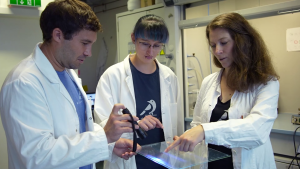
BirdShades CEO and co-founder Dominique Waddoup, at right, and her team look at treated glass and UV materials. BirdShades image.
“Our bird protection window film is active in the UVA-range, which is present in daylight,” describes BirdShades CEO and co-founder Dominique Waddoup. “Colours in this wavelength are imperceptible to humans but visible to birds. Thus, the film remains invisible to us. BirdShades makes it possible to protect birds without compromising aesthetics.”
She’s referring to the use of window treatments that are visible to humans, such as stick-on decals of larger birds or even visual markers like dot patterns or vertical lines, that are affixed to windows to reduce bird glass collisions.
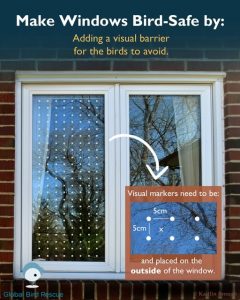
Best Practices for Bird Friendly Glass comes with several recommendations for treating windows (and adjusting lighting) to protect birds in flight.
(Bird silhouettes, the Toronto best practices guide says, have been tested experimentally and found to be largely ineffective. Birds may avoid hitting the decal if it is applied on the exterior surface of the window, but they may still hit glass beside the decal if the glass reflects vegetation or sky. To be effective, decals have to be applied on a window in a pattern of just five to 10 cm apart, be they silhouettes of birds of prey or simple dots. Any product that says it’s bird-friendly needs to have third-party testing results that show a significant reduction in bird collisions, the guide continues, and those results should be comparable to other treated glass solutions that are described in Toronto Green Standards.)
The first European adopters of BirdShades’ technology have reported good results, and the company’s window film has been tested and results documented in a report published in a peer reviewed journal, Ornis Fennica, with authors citing a five-fold reduction in bird glass collisions from the use of UV film. BirdShades, of course, references the study’s findings in its promotional literature, while also noting the need for continued research and refinement.
Meanwhile, organizations like FLAP Canada (for Fatal Light Awareness Program) and its BirdSafe initiative provide additional information about safe window treatments and other preventative measures that property managers, high-rise residents, and homeowners can take to safeguard migratory birds in an urban environment.
In particular, FLAP says that while UV window treatments are “theoretically an attractive option”, more testing and evidence of efficacy is needed. Birds may not notice UV markings that do not have a 20 to 40 per cent reflectance over the 300 to 400 nanometre wavelengths of UV, so FLAP Canada recommends choosing an alternative method until more is known. (A reply to an inquiry about BirdShades’ technical specifications was not received by press time.)
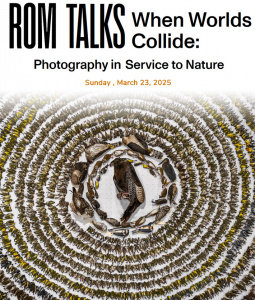
An award-winning photograph by Toronto-based artist and documentarian Patricia Homonylo is used to promote events that seek to reduce bird glass collisions. Artist image.
In other of its activities, however, FLAP gathers a lot of evidence that really, uhh, strikes home.
Over the course of just one year, FLAP Canada volunteers gathered, documented, and displayed some 4,000 birds that died following collisions with buildings across the Greater Toronto Area: the data makes a powerful point about the impacts of urban architecture on avian populations.
Even more poignant, the award-winning photograph by Toronto-based artist and documentarian Patricia Homonylo and its reminder that each bird collected represents not merely a data point but a life lost in the city.
Homonylo speaks for vulnerable animals and is active in many conservation causes, and she takes up the case of bird-glass collisions during in-person, hands-on workshops, on occasion working alongside German-Canadian conceptual artist Iris Häussler.
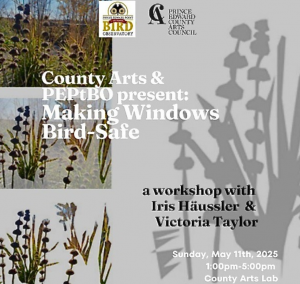
German-Canadian conceptual artist Iris Häussler and others deliver tips and advice on how to make bird safe window treatments during in-person, hands-on workshops throughout Ontario. Artist image.
In a recent event at the Art Gallery of Ontario, for example, nature films by Homonylo (like her stirring documentary When Worlds Collide) were screened and attendees were shown how to make their own anti-collision window decals, guided by Häussler.
Tips and advice for do-it-yourself, bird-friendly collision avoidance devices, be they high-tech or home-made, are plentiful. Still, calls for greater research into the efficacy of various approaches and materials remain (they have been made for years).
In 2013, a paper called Evaluating the Effectiveness of Select Visual Signals to Prevent Bird-window Collisions, was published in The Wilson Journal of Ornithology.
The authors, Daniel Klem Jr. and Peter G. Saenger, described how their experiments revealed that to be effective, UV signals used to prevent bird-window collisions must meet specific technical parameters; they cited the 20 to 40 per cent of light reflectance in 300 to 400 nanometre range criteria.
(Other tests showed that very thin parachute cord, when hung at specific distances in front of clear and reflective windows, is also an effective bird-window collision preventive method.)
The authors have concluded that the BirdShades external window film would be effective in reducing the damage caused by birds’ collision with windows, even as they call for testing of other mitigation technologies and make suggestions for testing standards to assess collision-reducing technologies.
Both Professor Klem Jr. (a leading ornithological expert based in the U.S.) and FLAP Canada contributed to Toronto’s bird-friendly window guide, and they were acknowledged for their assistance in developing the information therein.
# ##

“Lights Out Toronto” is an awareness campaign from the city designed to reduce bird deaths by turning off unnecessary lights during migratory season. City of Toronto image.
-30-



